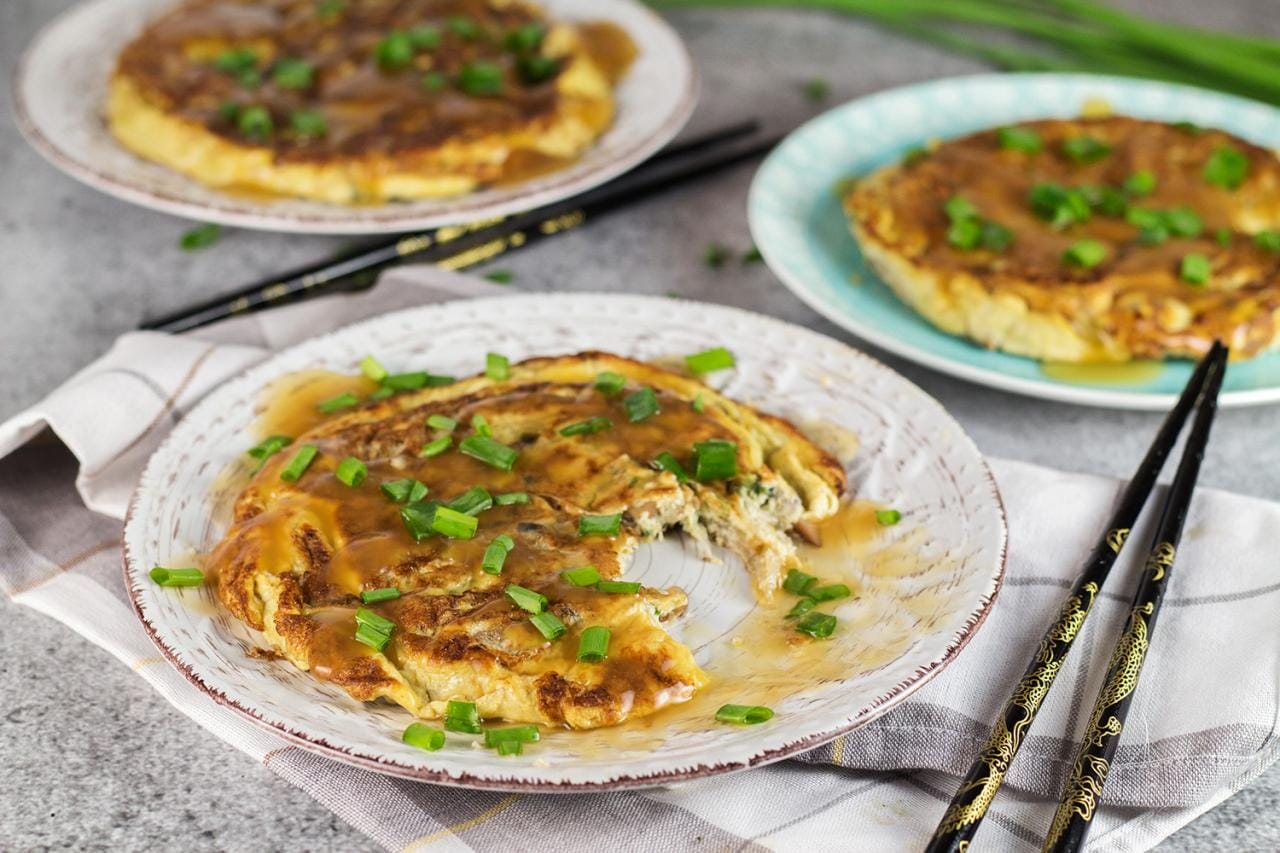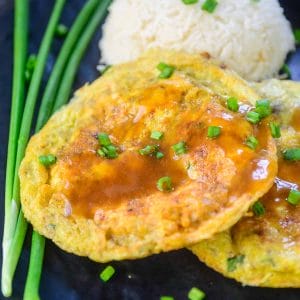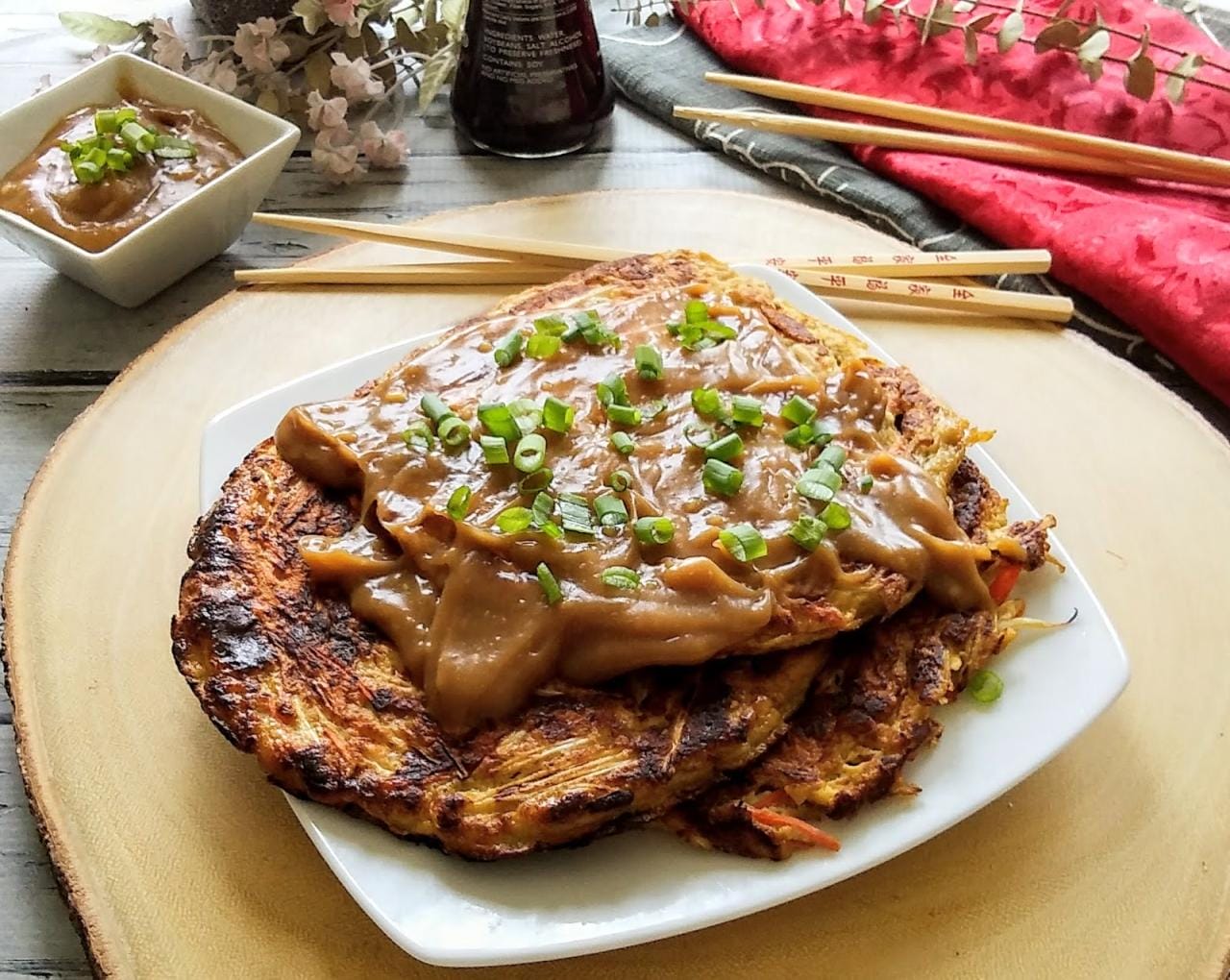Hello, dear reader! Today, I invite you to join me on a culinary adventure as we explore the wonders of a dish that has captured my heart and taste buds – the delightful Vegetarian Egg Foo Yung.
A Love Affair with Vegetarian Egg Foo Yung
My love story with Vegetarian Egg Foo Yung began on a warm summer evening at a local Chinese restaurant. The moment the dish was placed before me, I was captivated. The fluffy omelette, the vibrant sauce, and the medley of vegetables were a sight to behold. But it was the first bite that sealed the deal. The softness of the omelette, the savory sauce, and the crunch of the vegetables created a symphony of flavors that had me hooked.
The Art of Cooking Vegetarian Egg Foo Yung
Cooking Vegetarian Egg Foo Yung is like conducting an orchestra. Each ingredient plays a crucial role, contributing its unique flavor and texture to create a harmonious dish.
Since we’re skipping the recipe part, let’s delve into some cooking tips that can take your Vegetarian Egg Foo Yung from good to great. These are insights I’ve gathered over years of culinary adventures, and I’m excited to share them with you.

Chinese Vegetarian Egg Foo Yung
Equipment
- 1 wok
- 1 bowl
- 1 plate
- 1 separate bowl
Ingredients
- 3 tablespoons peanut oil or as needed
- Rice for serving
For omelet
- 6 eggs beaten
- 1 cup bean sprouts
- 1/4 cup green onions minced
- 1/4 cup Chinese cabbage shredded
- 4 water chestnuts minced
- 1/2 cup ground vegetarian meat substitute or tofu chopped
- 1 teaspoon soy sauce
For thickener
- 1 tablespoon cornstarch
- 2 tablespoons water
For Sauce
- 1 cup vegetable broth
- 1 tablespoon soy sauce
- 2 teaspoons sugar
- 2 teaspoons vinegar
- Rice for serving
Instructions
- In a bowl, combine the ingredients for the omelet. Mix well.
- Heat a wok over moderate heat. Swirl in the oil.
- Scoop out about 1⁄3 cup of the egg mixture, and spread it in a circular motion into the wok.
- When bottom is browned, flip it over to brown other side. Transfer it to a plate.
- Stir the egg mixture, and scoop to make another omelet. Repeat until the omelet mixture is used up.
- Combine the cornstarch and water to make thickener.
- Mix the ingredients for the sauce in a saucepan. Bring it to a boil and simmer.
- Stir in the thickener, and simmer until it is thick enough to coat a spoon.
- Serve with omelet (egg foo young). The sauce may be poured over the omelet, or served in a separate bowl. Place omelet over rice for serving.
Video
Notes
Cooking Tips

Creating the perfect Vegetarian Egg Foo Yung is a culinary journey, a dance of flavors and textures that come together to create a symphony on your palate. Here are some tips that I’ve gathered over the years, each one a stepping stone towards mastering this delightful dish.
- Choosing the Right Eggs: The soul of Vegetarian Egg Foo Yung lies in its eggs. Fresh, organic eggs are my go-to choice. Their rich yolks give the dish its characteristic golden color and creamy texture. If you can’t find organic eggs, free-range eggs can also work well.
- Preparing the Vegetables: Use a variety of colorful vegetables to make the dish visually appealing. Ensure they are cut into small pieces for even cooking. Traditional choices include bell peppers, carrots, and peas, but feel free to experiment with other vegetables like mushrooms or spinach.
- Mastering the Sauce: The sauce is the heart of Egg Foo Yung. It should be a balance of savory, sweet, and tangy flavors. Don’t shy away from using soy sauce for that signature umami taste.
- The Order of Ingredients: When making the egg mixture, always add the ingredients that take longer to cook first. This usually means the harder vegetables go in before the softer ones. This way, everything finishes cooking at the same time, and nothing ends up over or undercooked.
- Sauce Matters: The sauce is what brings everything together. It should be a balance of sweet, salty, and tangy flavors. Soy sauce, oyster sauce, and a touch of sugar usually do the trick. Don’t forget a dash of vinegar for that extra tang.
- Freshness is Key: Use fresh ingredients whenever possible. Fresh vegetables retain their crunch and color better than frozen ones, and fresh eggs have a superior taste and texture.
- Experiment with Spices: While soy sauce is a traditional ingredient in Vegetarian Egg Foo Yung, don’t be afraid to experiment with other spices. Chili flakes, cumin, or coriander can all add interesting flavor profiles to the dish.
- Don’t Overcrowd the Pan: When frying the egg mixture, it’s important not to overcrowd the pan. Too many ingredients can lower the temperature of the pan and cause the food to steam instead of fry. If necessary, cook in batches to maintain the high heat needed for a good fry.
- Take Your Time: While frying is a quick cooking method, don’t rush the process. Take your time to properly prepare your ingredients and heat your pan. This will ensure that your Vegetarian Egg Foo Yung turns out perfect every time.
Remember, cooking is as much about the journey as it is about the destination. So, take your time, experiment with these tips, and most importantly, have fun! After all, the best Vegetarian Egg Foo Yung is the one made with love.
The Best Way to Serve Vegetarian Egg Foo Yung

Serving Vegetarian Egg Foo Yung is not just about transferring the dish from the wok to the plate. It’s a culinary experience, an opportunity to showcase the harmony of flavors and textures that you’ve meticulously crafted. Here’s how I like to serve this delightful dish:
- Choose the Right Dish: A large, open dish or a shallow bowl works best for serving Vegetarian Egg Foo Yung. The wide surface area allows the colorful ingredients to be spread out and displayed, making the dish as visually appealing as it is delicious.
- Presentation Matters: When transferring the Vegetarian Egg Foo Yung to the serving dish, don’t just dump it in. Use tongs or a large fork and spoon to gently lift and place the omelette, ensuring that the vegetables and eggs are evenly distributed. This way, every serving will have a good mix of vegetables, eggs, and that delicious sauce.
- Garnish Generously: Garnishing is the final touch that can elevate your Vegetarian Egg Foo Yung from good to great. A sprinkle of chopped scallions adds a fresh flavor and a pop of color, while a few sesame seeds bring a subtle crunch.
- Serve Immediately: Vegetarian Egg Foo Yung is best served hot, right off the stove. The heat intensifies the aroma and flavors, making the dish even more enticing.
- Accompaniments: While Vegetarian Egg Foo Yung is a complete meal in itself, you can pair it with some steamed rice or noodles for a full-on Chinese feast. For those who like a bit of heat, a side of chili oil or Sriracha sauce can be provided.
- Set the Scene: Serving Vegetarian Egg Foo Yung is also about creating an atmosphere. Set the table with some nice dinnerware, light some candles, play some soft music in the background. These little details can enhance the dining experience and make the meal even more enjoyable.
- Personal Touch: Lastly, add a personal touch to your serving. Maybe it’s a special serving dish passed down through generations, or a unique garnish that you love. This personal touch can make the meal even more special and memorable.
- Interactive Dining Experience: Encourage your guests to serve themselves. This not only makes the dining experience more interactive but also allows each person to take as much or as little as they want.
- Consider Dietary Preferences: If you have guests with specific dietary preferences or restrictions, consider making adjustments to the dish or providing alternatives. For instance, you could prepare a separate batch with less spice for those who prefer milder flavors, or use gluten-free soy sauce for those with gluten intolerance.
- Enjoy the Process: Serving Vegetarian Egg Foo Yung is not just about the end result, but also about the process. Enjoy the smiles and compliments as your guests savor the dish, and take pride in knowing that you’ve created a culinary masterpiece that brings joy to others.
Remember, serving Vegetarian Egg Foo Yung is an act of love. It’s about sharing a dish that you’ve put your heart and soul into. So, take your time, enjoy the process, and most importantly, savor the reactions of delight and satisfaction from your loved ones as they dig in.
FAQs

Over the years, I’ve encountered several questions about Vegetarian Egg Foo Yung. Here are some answers that might satisfy your curiosity:
Can Vegetarian Egg Foo Yung be made gluten-free?
Absolutely! Just replace the traditional soy sauce with tamari or any other gluten-free soy sauce alternative.
Can I prepare Vegetarian Egg Foo Yung in advance?
Yes, you can. However, I’d recommend making it fresh whenever possible as the flavors are more vibrant.
Can I use other types of eggs for this dish?
Definitely! You can use any eggs you like. Duck eggs can also work, but they will give the dish a different texture.
What vegetables can I use in Vegetarian Egg Foo Yung?
You can use any vegetables you like. Bell peppers, carrots, and peas are some of my favorites.
Is Vegetarian Egg Foo Yung spicy?
Traditionally, no. But you can adjust the heat level according to your preference.
As I conclude this culinary tale, I find myself filled with a sense of contentment. Vegetarian Egg Foo Yung, for me, is more than just a dish. It’s a canvas where I can express my creativity, a comfort food that never fails to lift my spirits, and a culinary adventure that always leaves me excited for more.
So, my dear reader, I invite you to embark on your own journey with Vegetarian Egg Foo Yung. Trust me, it’s a ride worth taking.

